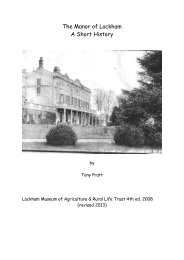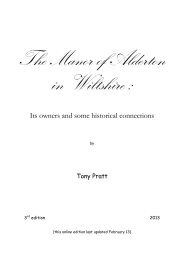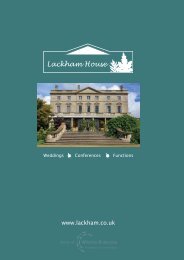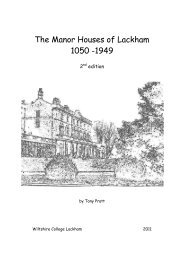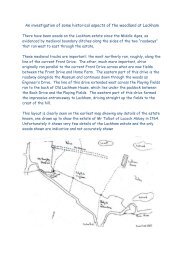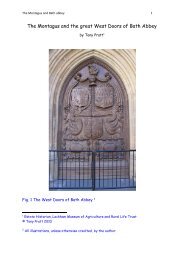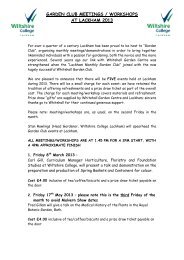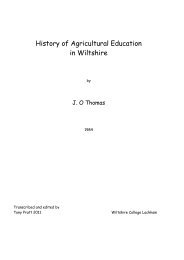Vol 1: The Bluets - Lackham Countryside Centre
Vol 1: The Bluets - Lackham Countryside Centre
Vol 1: The Bluets - Lackham Countryside Centre
You also want an ePaper? Increase the reach of your titles
YUMPU automatically turns print PDFs into web optimized ePapers that Google loves.
<strong>The</strong> <strong>Bluets</strong> 59<br />
Gilbert Marshal, Earl of Pembroke, [assigned] to his<br />
sister lady Eleanor, countess of Pembroke, of all the<br />
issues of the manors of Creadon, Stokholt, Kingewud<br />
Inteberg, and Clafford<br />
It is noteworthy that William and his co-witness Ralph, son of Richard<br />
are given as knights of the Countess , not the earl. <strong>The</strong> other witnesses<br />
indicate that William was associating with the great and the (not<br />
necessarily very) good of the country 233.<br />
<strong>The</strong>re appears to be a wide spread believe, especially among some<br />
transatlantic Bluet descendants, that the <strong>Bluets</strong> were the early Earls<br />
of Salisbury. A careful reading of the evidence makes it quite clear<br />
that this is not, never was, and never will be, the case.<br />
It is surprising that the confusion arises at all; the Earldom of Salisbury<br />
has been extensively investigated by medieval genealogists and it is<br />
accepted that the very first Earl of Salisbury was Patrick, 2nd son of<br />
Walter FitzEdward of Salisbury. Patrick was created Earl of Wiltshire,<br />
and styled Earl of Salisbury. He was attesting charters as Earl of<br />
Salisbury by 1142-1147, so we may assume he was also created earl by<br />
1142, by Queen Maud / Matilda. <strong>The</strong> original creation continued through<br />
the last female of this line, Ela, the daughter of Earl William who had<br />
equal rights in the avowson of St. Cyriac‘s church in Lacock, see above.<br />
After her father‘s death in 1196 she was given in marriage to the bastard<br />
brother of Richard I, one William de Longespee 234. <strong>The</strong> earldom was part<br />
of Ela's inheritance, and William became Earl of Salisbury, (and also Earl<br />
of Wiltshire). His line is also well documented; it ended with the last<br />
heiress Margaret marrying Henry de Lacy, Earl of Lincoln. <strong>The</strong>ir line<br />
ended with a single heiress named Alice who passed it to the Audley<br />
family. Neither the Lacys nor the Audleys used the title and, because of<br />
this, the king 235 assumed that the title had reverted back to the crown,<br />
and he granted it to his friend William de Montagu on 16th March 1337.<br />
It stayed with the Montagu family until it passed to the Nevilles, then<br />
233<br />
Calendar Patent Rolls Henry III vol 3 1232 – 1247 p125 <strong>The</strong> other witnesses<br />
were : Sir R. Earl of Poitou and Cornwall, Sir Hubert de Burgo, Earl of Kent, Roger<br />
le Bigod, Earl of Norfolk and Suffolk ―Sir R, Earl of Poitou and Cornwall,‖ is<br />
Richard, brother of Henry III, but he was only styled Count of Poitou at this time.<br />
However the French rank of Compte equates to an English Earl (My thanks to Leo<br />
van de Plas for his assistance with this<br />
234<br />
see the discussion on Ela, Lacock Abbey and William, below, for more details<br />
235<br />
Edward III



